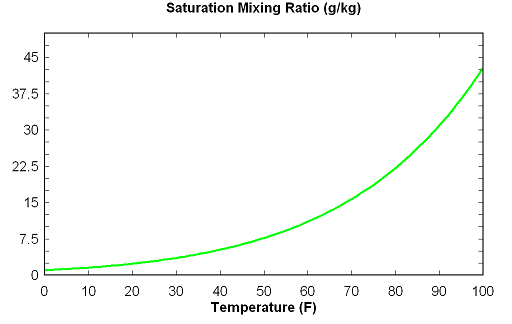Dewpoint, Relative Humidity
You hear meteorologists talk about the dewpoint a lot, yet a lot of people still prefer to hear the relative humidity. This blog attempts to explain these terms and how they relate to each other.
1. Mixing Ratio
We have to start with a boring one, because it helps explain the others. The mixing ratio is the amount of water vapor (humidity) in a given amount of air, usually given in grams of water vapor per kilogram of air. The warmer the air, the more water it can hold in vapor form. This amount of water vapor is known as the saturation mixing ratio at that temperature.
The chart above shows that air at 30 degrees F can only hold about 3.5 grams of water vapor per kilogram of air (g/kg), but air at 100 degrees can hold more than 10 times as much, or 42.9 g/kg of water vapor.
2. Dew Point
The dew point is defined as the temperature that, given an amount of moisture in the air (in g/kg), the air must be cooled down to for condensation to form. It is based completely on the mixing ratio of water vapor, so it is directly related to the amount of humidity in the air. The dew point can be determined from the chart. If the air has 20 g/kg of water vapor, then the dewpoint is 77 degrees. If it only has 10 g/kg the dewpoint is 57. This direct relationship to the amount of water in the air, without any dependence on the temperature, is why dew point is so appealing as an indicator of moisture.
3. Relative humidity
Suppose the temperature is 77 degrees. That means, from the chart, air can hold up to 20 g/kg of water vapor. But, if the dewpoint is 71, meaning the actual mixing ratio is 16.3 g/kg, then the air only has 16.3/20 the amount of water vapor it could hold at that temperature. 16.3/20 = 82%, so when the temperature is 77 and the dewpoint is 71, the relative humidity is 82%. If the air warms to 90 degrees but the amount of water vapor (in g/kg) does not change, the dewpoint will remain constant at 71, and the relative humidity will drop to 16.3/30.9 = 53%, even though the acutal amount of water in the air did not change. If the temperature were to drop to 71, then the relative humidity would be 16.3/16.3 = 100%, and condensation would begin (dew, fog, etc.)
The advantage is that, as long as the amount of water vapor in the air remains the same, the dewpoint does not change even if the temperature changes. But, the relative humidity changes.
On calm mornings, the dew point will actually drop somewhat as dew or fog forms, removing water vapor from the air and converting it to liquid water. Then, as the sun comes out and the dew/fog evaporate, the relative humidity drops, but the dewpoint rises.
Category: Uncategorized



















Comments (31)
Trackback URL | Comments RSS Feed
Sites That Link to this Post